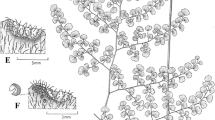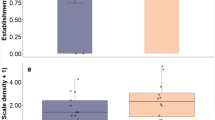Abstract
Data are presented on the ecology and production ofIcacina oliviformis (Poiret) Raynal in natural stands in northern Central African Republic. The species grows on a variety of soils and in numerous plant communities. It is fire adapted, and thrives when burned in the early dry season. The plant is primarily bee pollinated and has a number of pests that infest the stems and young fruits. Plant densities are high, with a maximum of ca. 5345 plants/ha in the study sites. Standing tuberous root biomass can be considerable, with a maximum of ca. 19904 kg/ha for the study sites. Seed yield in the sample sites was relatively low with a maximum of ca. 214 kg/ha. With proper management, yields of both seed and tuberous roots could be substantially increased.
Résumé
Un Aperçu sur une Plante Comestible Sous-Exploitée. III. Ecologie et Production. L’objet de ce papier est la presentation de I’écologie et la production dans des peuplements naturels d’Icacina oliviformis dans le nordde la République Centrafricaine. Cette espèce est adaptée a plusieurs associations phytoécologiques et à plusieurs formations pédologiques. I. oliviformis est une pyrophyte et pousse mieux sous un regime de brulis annuels. Les principaux vecteurs de pollinisation sont les abeilles. Les tiges et lesjeunes fruits sont attaqués par divers insectes nuisibles. Les densités maximales des plantes sont très elevées avec un maximum de 5345 pieds/ha dans les parcelles étudiées. La biomasse des tubercules peut être très élevée, atteignant 19 904 kg/ha dans les parcelles étudiées. La production annuelle de graines est assezfaible, elle atteind un maximum de 214 kg/ha. La production de tubercules et de graines pourraient être beaucoup plus élevées avec un systeme agricole approprié.
Similar content being viewed by others
Literature Cited
Andrews, F. W. 1952. The flowering plants of Anglo-Egyptian Sudan 2. Buncle, Arbroath.
Barber, K., S. Buchanan, and P. Galbreath. 1979. An ecological survey of the St. Floris National Park, Central African Empire. Report submitted to the Ministère des Eaux, Forêts, Chasses, et Pêches, Bangui, March.
Berhaut, J. 1975. Flore illustrée du Sénégal, vol. IV, p. 128–129. Gouvernement du Sénégal, Dakar.
Boulvert, Y. 1983. Carte pedologique de la République Centrafricaine@1:1,000,000. Office de la Recherche Scientifique et Technique Outre-Mer, Bangui.
Cerighelli, M. R. 1919. La farine des graines et la fécule des tubercules d’lcacina senegalensis. Annales de l’institut botanico-géologique colonial de Marseille 3:169–178.
Chevalier, A. 1913. Mission Chari-Lac Tchad (1902-1904). Etude sur la flore de l’Afrique Centrale Française (bassins de l’Oubangui et du Chari). A. Challamel, Paris.
—. 1935. Les îsles du Cap Vert: flore de l’Archipel. Révue Internationale de Botanique Appliqué et d’Agriculture Tropicale 15:733–1099.
Cottam, G., and J. T. Curtis. 1956. The use of distance measures in phytosociological sampling. Ecology 37:451–460.
Dalziel, J. M. 1937. The useful plants of West Tropical Africa. Crown Agents for the Colonies, London.
Davy, J. B., and A. C. Hoyle. 1937. Checklists of forest trees and shrubs of the British EmpireIII. Gold Coast Draft.
Fay, J. M. 1987.Icacina oliviformis: A close look at an underexploited crop. I. Overview and ethnobotany. Economic Botany 41:512–522.
—. 1991.Icacina oliviformis: A close look at an underexploited food plant. II. Analyses of the food products. Economic Botany 45:16–26.
Guillemin, J. A., S. Perrottet, and A. Richard. 1830. Florae Senegambiae Tentamen, tomus primus. Apud Treuttel et Wurtz, Parisiis.
Hull, C. H., and N. H. Nie. 1981. Statistical package for the social sciences update 7-9. McGraw-Hill, New York.
Hutchinson, C., P. Warshall, E. Arnould, and J. Kindler. 1992. Development in arid lands. Lessons from Lake Chad. Environment 34:16–20, 40-43.
Irvine, F. R. 1930. Plants of the Gold Coast. Oxford Univ. Press, London.
—. 1961. Woody plants of Ghana. Oxford Univ. Press, London.
Jussieu, A. 1823. Description d’un genre nouveau nomméIcacina. Mémoires de la Société d’Histoire Naturelle (Paris) 1:174–178.
Keay, R. W. J. 1958. Flora of west tropical Africa, V. 1, P. 2, p. 639. Crown Agents for Overseas Governments and Administrations, London.
National Academy of Sciences. 1984a. Environmental change in the West African Sahel. National Academy Press, Washington, DC.
—. 1984b. Agroforestry in the West African Sahel. National Academy Press, Washington, DC.
Nie, N. H., C. H. Hull, J. G. Jenkins, K. Steinbrenner, and D. H. Bent. 1975. Statistical package for the social sciences. McGraw-Hill, New York.
Okali, D. 1992. Sustainable use of West African moist forest lands. Biotropica 24:335–344.
Oliver, D. 1868. Flora of tropical Africa, vol. I. Reeve, London.
Pearce, F. 1991. Africa at a watershed. New Scientist 129:34–40.
SECA-S.A. AGRER N.V. 1991. Programme de developpement de la Region Nord. Rapport Annuel.
Sillans, R. 1958. Les savanes de l’Afrique Centrale. Lechevalier, Paris.
Stephenson, A. G. 1981. Flower and fruit abortion: proximate causes and ultimate functions. Annual Review of Ecology and Systematics 12:253–279.
Weisburd.S., and J. Raloff. 1985. Climate and Africa: Why the land goes dry. Science News 127: 282–285.
Wickens, G. E., J. R. Goodin, and D. V. Field. 1985. Plants for arid lands. George Allen and Unwin, London.
Author information
Authors and Affiliations
Rights and permissions
About this article
Cite this article
Fay, J.M. Icacina oliviformis (Icacinaceae): A close look at an underexploited food plant. III. Ecology and production. Econ Bot 47, 163–170 (1993). https://doi.org/10.1007/BF02862019
Received:
Accepted:
Issue Date:
DOI: https://doi.org/10.1007/BF02862019




